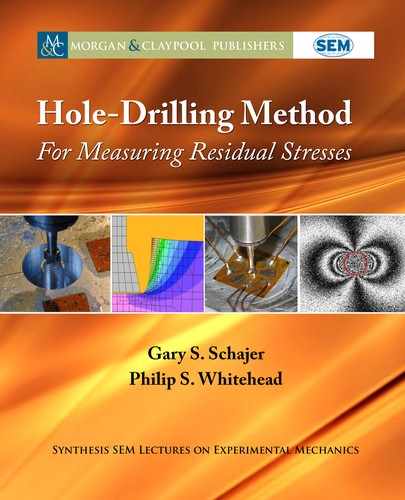
119
C H A P T E R 6
Example Practical Procedures
and Results
“Operator skill has been identified as probably the most important factor in achieving a reliable
and quality measurement.”
National Physical Laboratory Measurement Good Practice Guide No. 53 (2006).
is chapter describes practical examples of strain gauge installations to illustrate further aspects
of the Hole-Drilling Method. Sections 6.1–6.5 describe examples of rosette installations on
specimens in practical engineering situations. Sections 6.6–6.10 go on to present and discuss
further examples of residual stress measurements on a range of different types of specimens.
6.1 SPECIMEN GEOMETRY AND STRAIN GAUGE
SELECTION DETAILS
ASTM Standard Test Method E837 for hole-drilling describes the required characteristics of
an ideal test specimen. e measurement location on such a specimen has a plane smooth surface
that is remote from any obstacles, edges, or discontinuities such as holes or steps. In addition,
the specimen material is linear-elastic, isotropic and homogeneous.
It is convenient to express the dimensions of specimens as multiples of the mean gauge
diameter D. is is the pitch diameter of the gauge elements set around the target center. e
ideal specimen surface is flat, but curvatures with radii down to 2.4D can be accommodated
with little impact on the results. Another important property of the specimen is the material
thickness in the area of measurement. For specimens to be subjected to through-hole drilling
measurements, ASTM E837 lists the maximum thickness as 0.2D for Type A and Type B
gauges and 0.24D for the Type C gauge. For blind hole (incremental) drilling, the minimum
thickness is 1.0D for Type A and Type B gauges and 1.2D for the Type C gauge.
Figure 6.1 shows the layouts and key dimensions of the widely used Type A and Type B
strain gauge rosettes. Table 6.1 summarizes the geometrical requirements for specimen thick-
ness, distance from adjacent features and surface shape. e main specifications in the table
derive from the ASTM E837, with some additional suggestions based on the practical experi-
ence of the authors.

120 6. EXAMPLE PRACTICAL PROCEDURES AND RESULTS
Wg
Lg
Lg
de
ds
Wg
D
de or ds de1 or ds1
edge or
step-up
edge or
step-up
Type A
Patterns RE & UL
Type B
Pattern UM
D
Figure 6.1: Target strain gauge rosette layouts and key dimensions.
Key dimensions are:
D D mean gauge diameter
D
o
D nominal hole diameter
Lg D length of gauge element
W g D width of gauge element
de or de1 D distance to edge feature
ds or ds1 D distance to step-up feature
Dh D drilled hole diameter
zs
max
D maximum stress depth
e gauge size is the principal factor to be considered for measurement planning because
it determines the maximum depth to which residual stresses can be detected. However, the max-
imum gauge size may be limited by the specimen thickness and the proximity of the proposed
gauge location to any nearby specimen features.
e three types of ASTM strain gauge rosettes identified in Figure 4.1 (Chapter 4) are
manufactured in several sizes and configurations. Type A rosettes are manufactured in 1/32”,
1/16”, and 1/8” nominal sizes as “open” gauges (with an exposed metal surface) and in the 1/16”
size as an encapsulated gauge (with the metal surface covered by a protective film) with large
copper solder pads. Gauge leads can be soldered directly to the solder pads of encapsulated

6.1. SPECIMEN GEOMETRY AND STRAIN GAUGE SELECTION DETAILS 121
Table 6.1: Geometrical specifications for hole-drilling rosette use, adapted and expanded from
ASTM E837. Unless otherwise stated, dimensions are mm. (* indicates authors’ suggestions.)
Symbol ASTM E837 Rosette Type
CBA
Vishay Pattern - 031RE 062RE 062UL 125RE 062UM 030RR
Nominal element size Inches 1/32 1/16 1/16 1/8 1/16 -
Gauge mean diameter D 2.57 5.13 5.13 10.26 5.13 4.32
Gauge length L
g
0.8 1.6 1.6 3.2 1.6 ~0.8
Gauge width W
g
0.8 1.6 1.6 3.2 1.2 ~0.8
Nominal hole diameter D
o
1.0 2.0 2.0 4.0 2.0 2.0
Maximum drilled hole
depth
zh
max
0.5 1.0 1.0 2.0 1.0 1.25
Minimum specimen
thickness
ts
min
3.0 6.0 6.0 12.0 6.0 8.0
Min. distance to edge
feature
de
min
2.5 5.0 5.0 10.0 4.0 5.0
Min. distance to edge
feature
de1
min
2.8 5.7 5.7 11.4 - 5.0
Min. distance to step
feature*
Min. distance to step
feature*
ds
min
2.0 4.0 4.0 8.0 2.0 5.0
ds1
min
2.8 5.7 5.7 11.4 - 5.0
Min. radius of curvature* rc
min
6.0 12.0 12.0 24.0 12.0 12.0
Min. gauge-to-gauge
distance*
dg
min
6.0 12.0 12.0 24.0 12.0 12.0
gauges, while open gauges require the use of intermediate conductors soldered between the
rosette and remote terminal pads to which the gauge leads are soldered. e Type B rosette
is produced as an encapsulated 1/16” gauge while the Type C rosette is produced as an open
030-size gauge and is identified as pattern RR. Similar rosette patterns are produced by various
manufacturers and are all suitable for use providing their specific calibration data are used for
the residual stress calculation step.
e encapsulated type of strain gauge rosette is more robust and less prone to damage
during installation and soldering. us, it is advantageous for general-purpose use. However,
..................Content has been hidden....................
You can't read the all page of ebook, please click here login for view all page.
